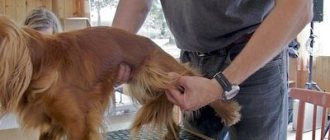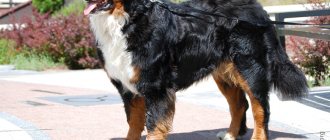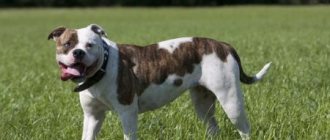History of Guide Dog Service
It is believed that dogs have been serving people as guide dogs for hundreds of years. The first mentions of them are found in the 16th century. But professional training schools for guide dogs appeared only four centuries later. In Germany, after the First World War, it was decided in this way to help military veterans. A little later, similar schools appeared in the USA, Great Britain and (after World War II) in Russia.
Thus, the first institution in the USSR was the Russian School for Training Guide Dogs of the All-Russian Society of the Blind, which opened in 1960. The second institution is a charitable organization for dog training.
In regulatory documents, guide dogs are called guide dogs. In many countries, these animals are not subject to restrictions on their presence in transport or public catering areas. Guide dogs even have their own holiday - it is celebrated all over the world on April 26th.
Guide dog - a more correct name for a guide dog, but less familiar
Functions of guide dogs
One of the main missions of a guide dog is to ensure the safety of the owner in public places, on the street, and in transport. These animals know how to warn of an obstacle, be it a curb, a hole, a puddle or a closed door. And dogs specially trained in their craft pay attention to overhead obstacles (tree branches, stretched ropes, wire, etc.). Ordinary dogs never notice such things.
Also, guide dogs have an impeccable command of the general training course, they know how to find and hand over lost and fallen objects to the owner, and find the entrance and exit from premises and vehicles.
And, of course, the main skill that is instilled in a guide dog during training is reasonable disobedience. The dog should not follow a command that could ultimately endanger its disabled owner. The guide animal must independently make the right decision.
Guide dogs can find and give small things to a blind owner
Rottweiler
The main quality for which this breed of guide dogs is valued is endless devotion to its owner. Their highly developed intuition, physical strength and speed have made them more than just a companion for many disabled people. They became protectors and guards. Patient and hardy, they will become an indispensable assistant in everyday tasks, and their developed intelligence and quick wits allow them to learn new tasks literally every day. However, the Rottweiler is not suitable for everyone: he has a tendency to dominate, so in order to get along and get along with him, you must have a strong and strong-willed character. When going outside, these dogs must be muzzled.
Read Top 20 best guard dogs for protecting a private home
Breeds of dogs that can become guides
A dog of any breed that has the necessary qualities and skills can serve as a guide for a visually impaired or blind person. However, the practice of training guide dogs has shown that representatives of some breeds are more easily trained in the special functions necessary for such service. Most often, dogs of service breeds (Rottweilers, German Shepherds), as well as Giant Schnauzers, Poodles, Collies and, of course, Labradors become guides.
General characteristics of breeds suitable for accompanying blind people:
- Intelligence and intelligence.
- Calm and gentle temperament, ability to suppress instincts.
- Stress resistance (the dog should not be afraid of city noises).
- Well-developed sense organs: smell, vision, hearing.
- Average size (height at withers - 65–70 cm).
- Loyalty to the owner.
Collie
The Collie is a herding dog with a tendency to protect its owner. This is a brave, quick-witted dog that is also good-natured and affectionate, making it great for helping blind children. Collie height ranges from 50 to 60 cm depending on the gender of the dog, and weight ranges from 22 to 32 kg.
Collies are perhaps the most beautiful dogs suitable for the role of guide dogs.
Labrador retriever, golden retriever
Labrador Retriever and Golden Retriever are the main breeds used to help blind people. According to the standards, a retriever is a hunting dog that is capable of bringing game to the hunter undamaged due to its calm disposition and soft jaw. These are dogs of strong build with a height of 51–61 cm and a weight of 27–36 kg. Labradors are distinguished by agility, courage, intelligence, good nature, insight and obedience. But the main feature of the breed is the desire to please the owner.
Retrievers are the most popular and most effectively trained guide dogs.
Mostly shepherd dogs and collies were used for training. But when Labradors appeared in the Union in 1989, it became clear that all other breeds were only conditionally suitable. The Shepherd is by default a dog with malice. It is good for protective guard duty. And the Labrador is a companion dog. She has a stable psyche. She is always happy to see a person, is not particularly afraid of anything, and will gladly work for a piece [of something tasty], and not under pressure. The latter is the main reason why this breed is most often used as a guide dog in the world.
Natalya Gromova, guide dog trainer
https://daily.afisha.ru/relationship/9620-lizyk-zayka-i-sobachiy-snikers-kak-zhivut-sobaki-povodyri/
German Shepherd
This is a service breed, whose representatives are so smart and loyal that they can be suitable for the role of a pet guide. Shepherds are easy to train and non-aggressive. The height of the German Shepherd at the withers is 55–65 cm, weight is 22–32 kg.
German Shepherds are service and hardy dogs that, thanks to their intelligence and loyalty, can cope with the role of a guide.
Poodle (large royal poodle)
The poodle is not just a beautiful circus dog. These animals, like retrievers, were previously used to carefully present game to hunters. They are capable of performing the role of guard, service and hunting dogs. In addition, poodles are sociable and playful, which makes them wonderful companions for blind people.
The Poodle is a versatile dog, hardworking and friendly.
The height of a large poodle is 45-60 cm, weight - 20-23 kg.
Poodles are highly trainable and therefore suitable even for novice owners.
Giant Schnauzer
Giant Schnauzers are famous for their amazing memory, which allows them to remember a large number of commands. In addition, they are excellent companions who adore their owner and children. At the same time, the “Rizens” are hardy and efficient. The height of Giant Schnauzers is 60-70 cm, weight - 35-45 kg.
Giant Schnauzers are intended for use as guards and companions, but they have also proven themselves successful as guide dogs.
Rottweiler
Before the popularization of retrievers, Rottweilers were used no less often than shepherd dogs as guide dogs. These are large and powerful animals, 61–68 cm tall and weighing 42–50 kg. Rottweilers are incredibly loyal, and also very brave and strong. They need serious training and strict upbringing. But the Rottweiler will always reward its owner with loyalty and selfless protection.
Rottweilers require strict training, but are smart and loyal enough to serve as a guide.
Raising and training guide dogs
In order for a dog to become a good guide, it is better to start training it from an early age. To raise a puppy that will perform a noble service, volunteers are chosen - educators. As a rule, when an animal reaches one year of age, it is adopted by the organization. Professional and almost daily training begins.
The dog learns to walk at a calm pace in a special harness to the left of the person (the owner will have a cane in his right hand), to bypass (not overcome) obstacles, not to react to external stimuli and make decisions.
After completing the course, the future guide takes an exam. The test consists of completing a route with a trainer who is blindfolded. It is also checked how the dog has mastered the general training course. Since training guide dogs is a long process, animals that fail are often given a second chance - sent for retraining.
And, of course, all guide dogs are sterilized; this has a positive effect on the suppression of instincts and the temperament of animals.
Those wishing to receive a guide dog fill out a form and stand in line; the wait can last about a year. In addition, not every blind person has the opportunity to get the desired pet - schools do not give dogs to people with mental disorders and lonely old people (and anyone who would find it difficult to care for an animal). Formally, the dog belongs to the organization. It is given free of charge and for life, but there are exceptions (the school has the right to check how the animal lives and feels, and to take it away for rehabilitation if necessary).
The introduction of a potential owner to a guide dog lasts for two weeks as part of the training. A blind person also takes the exam - it is important to find out how he will interact with the animal along the route.
In a word, raising and taming a guide dog is not an easy task, but a rewarding one. A visually impaired or blind person receives an animal companion and assistant, which means autonomy and independence.
Hera is part of my life and freedom. She is more than a helper, she is my friend. I trust her in a way that I don’t trust many people. We have a strong connection. Hera saved me once. We were returning from a walk when I discovered that I had lost the keys to the house. I was in a panic. Guide dogs are not very trained to smell and search, and there were huge snowdrifts on the street, but I decided to try the “search and fetch” command. I don’t know how, but Hera managed to find the keys. I kissed her all over!
Olga Lifanova, author of the project “With a dog all paths are open”
https://daily.afisha.ru/relationship/9620-lizyk-zayka-i-sobachiy-snikers-kak-zhivut-sobaki-povodyri/
Golden retriever
Representatives of this breed of dogs are wonderful companions and helpers who are ready to serve their owner day and night. They are sociable and friendly, but at the same time they perfectly sense the mood of those around them and will not impose their company at the wrong time. Smart, flexible, highly intellectually developed, which makes it possible to raise them as a devoted companion. Golden Retrievers are not prone to dominance, so they are perfect for someone who is getting a dog for the first time, but it is important to remember that their coat requires careful care. Height does not exceed 50-58 cm.
Read Breeds of long-eared dogs - top 20 rating











